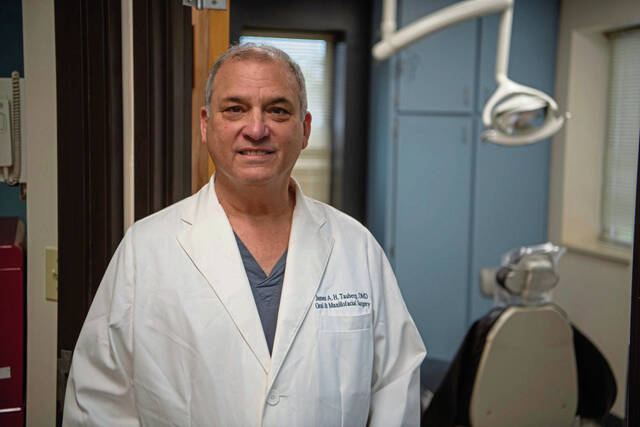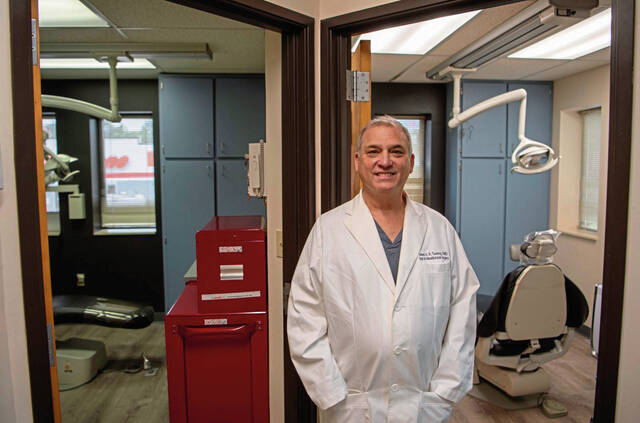Strained smiles as dentists struggle with staffing
If you’re in a rush to schedule a dentist appointment in Western Pennsylvania, you might be out of luck.
Covid-era retirements and departures from the industry, combined with inflation and a backlog of patients who couldn’t make it to the dentist during the early months of the pandemic, have combined to create staffing struggles and scheduling challenges.
At Bittner King Dental in Fox Chapel, new patients usually have to wait three or four months.
“We’ve been very busy. It’s kind of a double-edged sword. I’d rather it be busy than not, but we feel awful having to put off treatment for patients,” dentist Dr. Alison King said. “There’s a sense of urgency that isn’t relayed when we say, ‘This is something you need to get done for your health, but we don’t have an opening until two months from now.’ It’s kind of not our ideal way that we want to handle patient care.”
Dr. Jim Tauberg, an oral and maxillofacial surgeon whose office is based in Wilkinsburg, also has found himself more booked than ever. He has been working in dentistry for over 35 years.
“I have never been busier in my entire career, and I’ve always had a busy practice,” he said. “We used to be booked out a month, six weeks, and now I’m booked out eight, 10, 12 weeks in advance.”
As a dental surgeon, Tauberg does his best to see patients for consultations as soon as possible if there’s an emergency. But, in many regular dental offices, patients might struggle to find appointments because of the persistent staffing shortages.
“You may not get an appointment for six months or more,” Tauberg said. “And nationally — not just locally or state. This is a huge problem everywhere.”
Combined causes
Ward Blackwell, executive director of the Pennsylvania Dental Association, described the situation as a “perfect storm.”
During the early months of the pandemic, many dental practices could not operate, and some older dentists decided to retire early. Some older hygienists and assistants retired, too, and others left the field, he said.
“There was an acceleration of retirements, and hygienists and assistants kind of tended to change careers or retire,” Blackwell said. “From 2019 to 2022, there was a lot of mobility at that time, and Pennsylvania had a net loss of dentists — (more) left our state than came into our state.”
Inflation and pandemic supply chain issues also hit the industry, increasing overhead costs, he said.
“Everything you can imagine put economic pressure on dentistry,” Blackwell said. “Your typical practice had their expenses go up, but not really their income level, yet they’re under pressure to pay more to try and recruit what workforce is out there. The hygienists and assistants often left because, during the pandemic, there wasn’t sufficient work, and they were having problems with child care.”
The dental workforce is depleted and will take time to rebound, as new dentists, hygienists and assistants will need to make it through their training programs.
“It’s definitely clear that there is simply not enough of a dental workforce to treat the population, and there’s different reasons why — fewer dentists, fewer hygienists and fewer assistants,” Blackwell said. “In a typical practice, that means there are more patients potentially coming in, but they simply don’t have the same capacity as three or four years ago to treat.”
A dearth of assistants, hygienists
Tauberg’s practice is looking to hire a dental assistant and a receptionist. The dental assistant position has been open about six weeks, he said.
King’s office, which sees about 30 patients a day, employs two dental assistants and one hygienist. It recently filled a dental assistant position, but the role was vacant for about four or five months.
“It was a struggle. We have a fairly recent hire, but it was many months of interviewing, and we really didn’t get that many applicants for the position,” she said, noting the office is fully staffed.
“We did find some temp work to fill in, (but) there were times that we couldn’t find anybody, and we did have to adjust the schedule. We can work alone in some ways, but it’s hard with some different procedures to not have an assistant. So there were days that we had to adjust the schedule because we didn’t have any assistants,” King said.
A July survey from the American Dental Association said, nationwide, 82.5% of dentists surveyed said it is “extremely challenging” to recruit dental hygienists, the staff members who initially clean a patient’s teeth before an examination by a dentist. Just more than half of the respondents said recruiting dental assistants also is extremely challenging.
Next generation
Paul Currie, dean of health professions at Westmoreland County Community College, oversees a dental hygiene, dental assistant and expanded function dental assistant program at the school.
About 70 students are in the program as of this semester. The number of students declined slightly during the pandemic, and he expects next year’s class to be closer to 80 students.
Currie said backlogs from patients who skipped appointments during the height of covid, combined with staff stress over the course of the pandemic, exacerbated the staffing shortage.
“The clinics were closed, the older hygienists and older dentists and older assistants said, ‘Now’s a good time to call it.’ And then, on top of that, coming out of it, when the storm of patients came in, we’ve got clinics trying to do 26 patients a day with one hygienist,” he said. “That’s hard on the hygienist, and they stop and go, ‘Well maybe I need a different career.’”
Currie’s students are heading into a buzzing job market, he noted.
“Our graduates are in extremely high demand,” Currie said. “My hygiene graduates pretty much have their pick. If one of them says, ‘I am available to work X amount of days,’ they’re getting snatched up.”
Outlook
The dental industry’s woes will take time to sort out, in part because students need to make their way through the secondary education system. King expects it to be a while before things stabilize.
“We still might be in the trenches for another couple of years before everything can catch up,” she said. “I think we’re getting there, but we’re still a few years behind.”
Blackwell doesn’t believe the industry automatically will fix itself with time and says funding and reimbursement adjustments might be needed to right the ship.
“It’s going to take action by a lot of different parties — dental education institutions, the state and federal government to some degree, but mostly the state in terms of reimbursements to medical assistance programs, and all third-party payers,” he said. “At some point, you can’t simply ignore that inflation has hit everywhere. I know employers don’t want to see their costs for dental insurance go up, but that doesn’t work on an economic basis. At some point, it just needs to even out a little bit.”
There is no “silver bullet” to solve the staffing problem, he noted.
“It’s going to take multiple parties, all engaged in different ways, to try to help us bring the dental workforce and capacity back up to a level that is sufficient for the population we serve,” he said.
Julia Maruca is a TribLive reporter covering health and the Greensburg and Hempfield areas. She joined the Trib in 2022 after working at the Butler Eagle covering southwestern Butler County. She can be reached at jmaruca@triblive.com.
Remove the ads from your TribLIVE reading experience but still support the journalists who create the content with TribLIVE Ad-Free.


